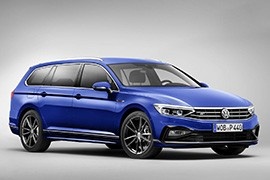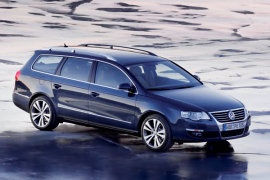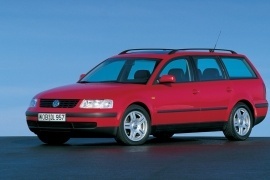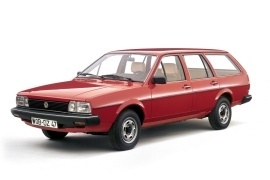
VOLKSWAGEN Passat Variant
Generations Timeline, Specs and Pictures

After no less than 30 million Passat models have been produced over the span of 7 generations, the eighth iteration of the nameplate in Variant guise was unveiled in 2019.
Thanks to a cornucopia of technology infused in the model, most of it having trickled down from some of the more expensive car brands under the Volkswagen Group umbrella, the eighth generation of the Volkswagen Passat has received one of the most technologically advance mid-cycle facelifts in its history.
Thanks to new hardware and software, the new Digital Cockpit has been massively improved compared to the previous Active Info Display. With much enhanced graphics and improved features, the system now offers three various display configurations can be customized using the redesigned multifunction steering wheel. Still part of the Passat Variant lineup, the GTE plug-in hybrid has received a considerably higher all-electric range, with up to 55 kilometers being covered in the WLTP cycle, which correspond to approximately 70 kilometers in the old NEDC.
All gasoline engines now feature particulate filters as standard, while on the diesel front there is a new 2.- TDI Evo engine choice. With an output of 150 horsepower, the powerplants emits 10 g/100 km less CO2 compared to its predecessor. The gasoline engine lineup has been completed with three new engines with 150 horsepower, 190 horsepower and 272 horsepower, respectively.

As with the sedan version, the 2015 Volkswagen Passat Varian debuted with a new design that combines styish clarity with a high level of impressive power, both reflected on the interior and exterior.
The exclusive image of the new Passat was achieved in part by a wide variety of extremely precisely drawn edges and creases which develop individual light-reflecting surfaces. The radiator grille is designed to be significantly larger than the headlights. In all three equipment versions (Trendline, Comfortline, Highline) it is upgraded by four chrome bars. On the sides, these bars bend inward towards the headlights in a trapezoid shape. The lowermost chrome bar of the grille is continued into the headlights. Above the grille and the headlights there is another chrome accent which extends across the entire width of the front end, and it is continued laterally in the character line (from “Highline”). Volkswagen developed an entirely new lighting design for the eighth-generation Passat. The car is being offered with halogen and LED headlights. In particular, the LED headlights that are offered in two versions create an unmistakable look. Inside, the designers placed special value on a driver-oriented design and a very spacious feeling of the front interior area. Therefore, starting from the seating position of the driver, the dashboard builds upwards in the space to the two sides of the instruments, inclined slightly towards the windscreen. This creates a spacious feeling as well as an ideal ergonomic landscape.

Volkswagen refreshed the Passat’s sixth generation and claimed that it was the seventh generation even though it was the same old car underneath the new look.
When Ford facelifted the first Mondeo generation in Europe, it changed more than 1,400 parts on it, and the car looked completely different. Yet, it didn’t call it a new generation. A new model, perhaps, was the correct name. But not a new generation, such as the German carmaker did with the Passat, in its both shapes, the sedan and the station wagon, called Variant.
Parked next to its 2005 sibling, the 2010 Passat Variant looked different but sported almost the same wheelbase, and it was based on the same MQB platform used by Volkswagen from the Polo to the Tiguan. The car’s front featured new headlights, with a rectangular shape instead of the 2005 model. Also, the design team installed a new grille with three slim slats spread between the headlights. Its bumper sported a new apron with angular-shaped fog lights.
The interior was reworked, and the German form-follow-function concept worked better this time. Finally, Volkswagen understood that the parking button must stay on the center console, not next to the lights knob on the dashboard. There was a new infotainment unit and climate controls. To make the car looks more upmarket, the Passat sported a round analog clock above the center stack. Its trunk was the same, offering 513 liters (18.1 cu-ft) with the rear seats up and up to 1641 liters (58 cu-ft) with the entire bench folded.
Under the hood, Volkswagen worked on its engine lineup to make them pass the European and the U.S. standards. The gasoline versions went well, but the diesel ones started the fire called Dieselgate.

Volkswagen introduced the Passat’s sixth generation in 2005 and, along with the sedan version, unveiled the station wagon model.
The fifth generation of the Passat was a highly successful model. Its reliable, fuel-efficient engines and large interiors made the Passat V an excellent vehicle. The sixth generation had to live up to its predecessor’s standards, and the engineers tried their best to make that happened. Unfortunately, the 2007 world financial crisis hit hard the sales, and the car’s underpinnings were not at the same level as on its predecessor’s.
The 2005 Passat displayed a new concept for the front fascia, with specific headlights that featured an enlarged, circular area for the high and low beams. In station wagon shape, it featured an extended roof, different rear doors, and a redesigned back with a liftgate. The taillights showed a very similar design to the ones installed on the sedan version.
Inside, the car featured one of the most unusual items on the market: a chromed Passat badge placed inside the instrument panel, on the upper side. Depending on the trim level and options, silver or wood trims adorned the center stack and the center console, but the door panels were black on their upper side and upholstery-colored on the lower side. For the station wagon version, the Passat VI Variant featured a 60/40 split-folding rear bench, increasing the trunk size from 513 liters (18.1 cu-ft) to 1641 liters (58 cu-ft). With a tire repair kit instead of a full-size spare, the car offered an additional 90 liters (3.2 cu-ft) of space under the trunk floor.

Volkswagen introduced in 2000 a facelifted version for the 1997 Passat and improved it in more areas to make it more appealing.
Also known as the B5.5, the 2000 Passat Variant received a few updates as its sedan sibling. It was a family station wagon, and its core customers were looking for a practical, reliable vehicle with a tremendous amount of space in the trunk.
At the front, the small rectangular headlights from the 1997 model were gone. Volkswagen installed reshaped headlamps and turn signals. The carmaker adorned the grille’s horizontal slats with chromed lines to make the car look more upmarket. Following the same idea of a higher quality product, it replaced the black rubber strips with color-bodied ones. A new set of taillights with butterfly-shaped reversing lights lenses made a clear difference in the rear.
Volkswagen improved the 2000 Passat interior by adding new climate control buttons on the center stack. Depending on the trim level and the options, the carmaker included better infotainment systems on the offer, with satellite navigation. For the instrument panel, the German carmaker added shiny silver rings around the dials and gauges. Like its predecessor, the Variant offered a 60/40 split-folding rear bench, which increased the trunk size from 495 liters (17.5 cu-ft) up to 1,600 liters (56.5 cu-ft).
Volkswagen’s engine choices played a significant role in Passat’s sales. The carmaker offered it with an extensive power range from a fuel-efficient 1.9-liter TDI unit that provided 100 hp up to a 4.0-liter W-8 gasoline engine with 275 hp. It was available with front or all-wheel-drive, with manual or automatic (Tiptronic) transmissions.

The 1997 Passat was one of the best cars ever built by Volkswagen and, in the station wagon shape, was a mid-size hauler big enough to move a student to and from the college in one trip.
While it was named Passat B5, it was actually the fourth generation of the mid-size contender for the German carmaker. The third generation was called T3 for the initial model, and the facelifted version was named B4 by the German carmaker, even though it was not a new vehicle. But the B5 remained the cornerstone in the Passat range.
In the Variant (station wagon) shape, the Passat was that kind of decent vehicle that didn’t ask too much to buy it or to run it. Its design was bold for a Volkswagen. At the front, it showed rectangular headlights with corner-mounted turn signals, but Volkswagen rounded the overall look. In the back, the carmaker installed rectangular taillights that flanked the wide tailgate.
Inside, the carmaker chose to play as safe as on the exterior the curved instrument cluster hosted four dials and a TFT display between the speedometer and tachometer. On that, the optional navigation system could show directions with pointed arrows. There were two bucket seats at the front and a 60/40 split-folding bench in the back. With the seats up, it offered 495 liters (17.5 cu-ft), while with the seatback folded, it provided up to 1,600 liters (56.5 cu-ft)
Under the hood, Volkswagen offered a vast engine range with gasoline and turbo-diesel. In terms of fuel efficiency, it was one of the best on the market, mainly thanks to its TDI engines, which were not available in all countries.

Volkswagen introduced a heavily revised third-generation Passat in 1993 for both versions: the sedan and the station wagon.
The German carmaker was not ready to change its mid-size segment vehicle, the Passat, while Ford was ready to storm the market with a completely new Mondeo. But Volkswagen made an intelligent choice to upgrade its third-generation Passat and named it a fourth-generation, even though the roof, the greenhouse, and the platform were the same as its predecessor. On the other hand, the door panels, the hood, and the fenders were new.
At the front, Volkswagen’s designers created a new front fascia with a slatted grille and elongated, horizontal headlights. Unlike the second generation, from the Passat B3/B4, the carmaker offered it only as a three-box sedan or as a station wagon, dropping the hatchback version. The carmaker installed the taillights on the quarter panels, extended them on the sides of the tailgate. A black rubber strip protected the upper bumper area when loading and unloading.
Inside, the comfortable interior offered a revised interior. The center stack was tilted towards the driver and provided easy-to-access controls and commands. Depending on the trim level and engine version, the Passat featured high-bolstered front seats or plain bucket seats at the front. Volkswagen installed a bench for two in the back, with a 60/40 split seatback, which increased the trunk from 465 liters (16.4 cu-ft) up to1,500 liters (52.9 cu-ft).
Under the hood, the Passat offered a choice of eight engines, either gasoline or diesel. Volkswagen brought only a few of them on the U.S. market: a turbo-diesel and a 2.8-liter V-6. The former was available exclusively with a five-speed manual, while the latter offered an option for a four-speed automatic.

Volkswagen introduced the third generation of the Passat at the 1988 Geneva Motor Show, and it was available in two body versions.
With the hatchback axed from the lineup, the Variant version remained the roomiest version from VW stable, apart from the minivans. It was the first Passat built on top of a Volkswagen platform and the first that featured a transverse engine instead of a longitudinally one as on its predecessors.
The Passat competed in the mid-size segment with many other European cars and, in the U.S., with the Japanese and the American carmakers. In station-wagon shape, it had a smaller competition, but the market was also smaller. At the front, the station wagon featured a flat panel that covered the area between the squared headlights. Volkswagen relied only on the bumper-mounted grille to cool the engine. The overall clean design had nothing to impress and nothing to bother. Its extended roofline towards the back of the car covered the trunk area and ended into a vertical drop on the tailgate.
Inside, the dashboard was improved and featured a wide instrument cluster extended over the center stack. It included the center vents as well. The German engineers considered placing the sound system above the climate control system. Unlike most cars on the market, the Passat was available with an automatic climate control system named Climatronic (EU-spec only). The carmaker installed two seats at the front and a wide bench for three in the back, with a folding seatback, which increased the trunk area from a decent 465 liters (16.4 cu-ft) to a respectable 1,500 liters (52.9 cu-ft).
Under the hood, depending on the market, Volkswagen installed a wide engine choice ranged between 68 hp and 174 hp. The standard transmission for the entire range was a five-speed manual, while a four-speed automatic was available on specific versions.

The second generation of the Passat made its appearance in 1981, and it was available in three body-shapes: sedan, hatchback, and station wagon.
While the first generation was a shy temptation to open the doors for a new era, the second generation of the Passat established the vehicle’s place on the market dominated by French and Italian carmakers. It was also known as the Passat B2.
Its angular lines, the big rectangular headlights, and the plastic bumper were a fresh look on the market. Like its siblings, the hatchback and the sedan, it offered big windows to increase visibility. The side panels and doors were slightly curved to create the image of a more exclusive vehicle, and the pull handles were another novelty on the market. A big tailgate with a wide opening allowed easy loading and unloading. Its taillights were smaller than those found on the hatchback or the sedan and placed only on the quarter panels’ rear side.
Inside, the Passat was roomy, with ample legroom and headroom for up to five passengers. The folding rear bench seatback increased the trunk volume from 745 liters (13.7 cu-ft) to 1575 liters (56 cu-ft). Volkswagen installed two large dials for the speedometer and tachometer in the angular instrument cluster, and two smaller gauges for the fuel level and coolant temperature. There was an area with ten lights for turn-signals, hazard, oil-pressure, parking brakes, and a few other important warning lights in the middle.
Volkswagen offered the Passat with a wide choice of engines, both diesel, and gasoline. Its long-range autonomy, of over 1000 km (623 miles), made it one of the most cost-effective cars on the market. Its reliability and low running costs increased over the years.

In 1973, Volkswagen launched the first generation of the Passat.
At first, it showed only the sedan with four-doors and the liftback with three and five doors. One year later, a station wagon version appeared. From the mechanical point of view it was just like an Audi 80, but with a different badge and not the same options. It was intended to be a car for the masses, just like the carmaker’s name suggested: Volkswagen (car of the people).
The station wagon Passat received a longer rear overhang to accommodate a bigger trunk. In the U.S. the car was known as the Volkswagen Dasher. It had only one engine available, a 1.5-liter unit. Two years later, a 1.6-liter fuel injected engine was introduced. The transmissions available were a 4-speed manual or a 3-speed automatic.
The interior features were limited. Neither central locking, power window or air-conditioning were available. At that time, most American cars already had air conditioning and bigger engines. That said, the Passat was very fuel-efficient. In the late ’70s it received a 1.5-liter diesel unit, which was very slow with a 0-100 kph (0-62 mph) acceleration time of 19.4 seconds.
In 1978, the Passat received a facelift and it wasn’t until 1982 when a new generation for the Passat was introduced. For today’s standards, the first-generation Passat was smaller even for the compact segment, but it was sold as a medium-sized station wagon.























































